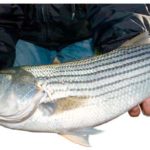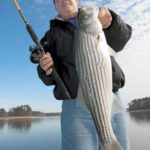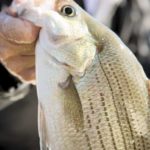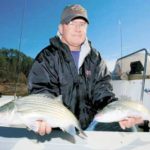
During winter, when most game fish become sluggish, stripers and hybrid bass are heating up at Lake Thurmond.
“Winter is definitely my favorite time of the year to be on the water chasing hybrids and stripers,” said Wendell Wilson, a guide at Lake Thurmond. “There are lots of fish, they’re relatively easy to find, and they tend to run a little bigger.
“You can also fish throughout the day during this time of year. There’s no need to get up and on the water before the crack of dawn like you do in the summer.”
Lake Thurmond is “Striper Central” in South Carolina when late-autumn and winter temperatures cool the water’s surface. Forty-pound fish are caught every year at this huge impoundment, and many of these monsters are caught during the winter months.
“J. Strom Thurmond Lake dams the Savannah, Broad, and Little Rivers and impounds almost 72,000 acres and creates 1,200 miles of shoreline,” said William Jabour, aquatic biologist for the U.S. Army Corps of Engineers for Hartwell, Russell and Thurmond lakes.
Completed in 1954, Lake Thurmond originally was named Clarks Hill Lake. It was the first of three Savannah River lake projects built that make up the South Carolina-Georgia state border. Today Thurmond is one of the largest and most popular recreational lakes in the southeast.
Many locals, particularly at the Georgia side, still refer to the lake as Clarks Hill.
“When the adjacent Trotters Shoals project was named after the popular Georgia senator, Richard B. Russell, in the 1980s, both states agreed to rename Clarks Hill Lake after South Carolina Senator Strom Thurmond,” Jabour said. “Georgia folks are a little more reluctant to adopt the new name than the South Carolina neighbors.”
However, striper and hybrid fishing from the lake of either name is just as sweet.
Wilson fishes and guides at Lake Hartwell and Russell for stripers and hybrids in addition to Lake Thurmond. He heads to Thurmond when his clients want a shot at a true trophy fish.
“There is much less underwater structure and standing timber in Thurmond than you find in Russell and Hartwell,” Wilson said. “That allows you to find fish much easier on a graph or fish-finder. It also gives you a much better chance at landing that big fish once it’s hooked.”
Locating stripers is the first task.
“Begin by looking for schools of fish in tributary arms of the lake,” Wilson said. “Rivers are always my starting point when locating fish in the winter.”
Fishing Creek, Pistol Creek, and Newford Creek on the Georgia side of the lake, are good areas to start. Little River on the South Carolina side is also a certified hot spot during winter.
Once anglers arrive at one of the tributaries, they need to scan the water for feeding and diving birds.
“That’s the key to finding fish this time of year,” Wilson said. “Gulls begin arriving here at Thurmond sometime in November and stay throughout the winter. They give fishermen a huge advantage that we simply don’t have during other times of the year.
“A good fish-finding strategy is to simply ride the tributary arms of the lake, look for flocks of gulls, and then work that area. Even if fish aren’t actively feeding and pushing up bait at that time, the gulls will usually just sit on the water in the right general area. If you spot gulls sitting on the water but not feeding, it means something just happened or is about to happen. Either way, the fish are nearby.”
Diving and squawking gulls are a sign that bait pods have been corralled by schooling stripers and hybrids and are being pushed up to the surface. The sight of fish actually rolling on the surface indicates a feeding frenzy is underway.
In addition to looking for feeding gulls, don’t forget to use a graph or fish-finder to locate suspended fish near underwater humps, river-channel drops, submerged standing timber, and the clear water immediately ahead of muddy water flowing down lake after a hard winter rain.
The classic winter striper approach is to use live bait. Blueback herring, threadfin shad and gizzard shad make up most of the Thurmond Lake’s abundant forage base. Any of the above, as well as minnows and shiners, are effective bait choices for stripers and hybrid bass.
Stripers like baits with lots of natural action, so it’s important to keep the live bait as fresh and lively as possible. A good live well with an aerator is essential. Products such as Baitfresh also aids in maintaining fresh baitfish.
At first glance, this seems like easy, no-brainer fishing. Nothing could be further from the truth.
In spite of their large size and reputations for having voracious appetites, stripers and hybrids can be incredibly finicky about what they eat and when they eat it. This quirk seems exaggerated as water temperatures cool. There’s clearly more than one way to soak a shiner, and the proper presentation of a baitfish can mean the difference between success and failure.
“Fishing with flat lines and drop lines are my two preferred live-bait methods,” Wilson said. “Keeping a couple of rods outfitted with casting spoons or plugs is also a good idea when fish are schooling up near the surface.”
Flat-lining involves slowly drifting live baits behind the boat using the river’s current, wind, or thrust of a trolling motor.
“If I’m after big fish, I like to keep my bait at least 50 yards from the boat when flat-lining,” Wilson said. “I feel the bigger fish are slightly smarter and more boat-shy than the smaller fish.”
Varying the boat speed or maneuvering through gentle S-curves will slowly lift and drop the bait. This enticing action often elicits vicious strikes from aggressive stripers.
Wilson uses two medium-action bait-casting rods with 14-pound-test and 2/0 Lazersharp Eagle Claw hooks for his flat lines. A split shot or two can be added to the line to help get the bait slightly deeper if needed.
For suspended fish in water 12 feet or deeper or for fish hugging the bottom, drop lines are deadly. Drop lines — also called down lines — are weighted live-bait rigs fished vertically from the side of the boat. Being able to precisely control the bait’s depth makes this technique so effective.
“For fish near the bottom, I use a 1-ounce egg sinker, a 2/0 Lazersharp Eagle Claw hook and a 24-inch leader of 17-pound fluorocarbon,” Wilson said. “Drop the bait until it reaches the bottom, and give the reel a turn or two before putting the rod in its holder.”
For suspended fish, the bait should be lowered to the approximate depth of the graphed fish and lifted a reel turn or two. Stripers and hybrids are known for not chasing baitfish suspended deeper than they are, so lines should be set slighter above the depth of the fish.
When a big striper hits, a fisherman needs to be ready. Make sure the rod is securely in the rod holder and the reel’s drag set correctly. When a big striper or chunky hybrid hits a bait, it’ll leave little doubt.
Casting into a frenzy of feeding, thrashing stripers is one of the most exciting methods of catching winter stripers and hybrids.
“I keep a couple of rods rigged with various lures to throw into the schools of fish when feeding near the surface,” Wilson said. Barry’s Flex-It Spoons and Little Fishies are his lure choices during these situations. Any shallow-running crankbait or bucktail will work.
If fish are in the area, the best way to cover a lot of water is by using a combination of all three methods.
“I like having two flat lines out of the back of the boat and three or four down lines at different depths off the side at the same time,” Wilson said. “I’ll drift with the wind or give the trolling motor a bump now and then.
“This covers a lot of water at different depths and really increases my chance of hooking up. All the while, I’m keeping an eye out for gulls and rolling surface fish. I’ll pick up a casting rod when that happens.”
The South Carolina Department of Natural Resources and the Georgia Department of Natural Resources collectively stock more than 1 million stripers and hybrids in Lake Thurmond each year.
Stripers and hybrid bass school and feed together.
“On any given trip, we’ll average equal numbers of stripers and hybrids,” Wilson said. “Some days we catch considerably more stripers and other days more hybrids. There’s no rhyme or reason to it“
Thurmond Lake stripers are sleek, strong, and grow to true lunker status. Hybrids, on average, are smaller but are stocky, hard-fighting, football-shaped pigs. The healthy look and feel of these fish is a testament to the lake’s incredibly abundant forage base.
On any given day, there is the opportunity to catch the “Morone Grand Slam“ at Thurmond Lake. “Morone” refers to the genus of temperate bass that includes the striped bass, hybrid bass, white bass, and white perch. All four species can be caught at Lake Thurmond using the techniques outlined above.
South Carolina and Georgia have a reciprocal licensing agreement that allows legally-licensed anglers to fish anywhere on Thurmond Lake. Statewide striped bass regulations apply, with a combined striper/hybrid limit of 10 fish, with no minimum size regulations.
There is excellent access around the lake, with 38 access points with boat ramps. These include dozens of state and county parks and USCOE recreation areas that make all areas of the lakes easily reachable.
When it’s 31 degrees outside, the wind howling out of the north and the last drop of hot chocolate drained from a Thermos, it might be tempting to exit the water and head for the warm truck and go home. But a trophy-sized striped bass is a fish worth enduring some discomfort to catch.
Be smart, dress warmly and wait patiently. It’s only a matter of time before the striper of a lifetime takes aim at your bait.








Be the first to comment